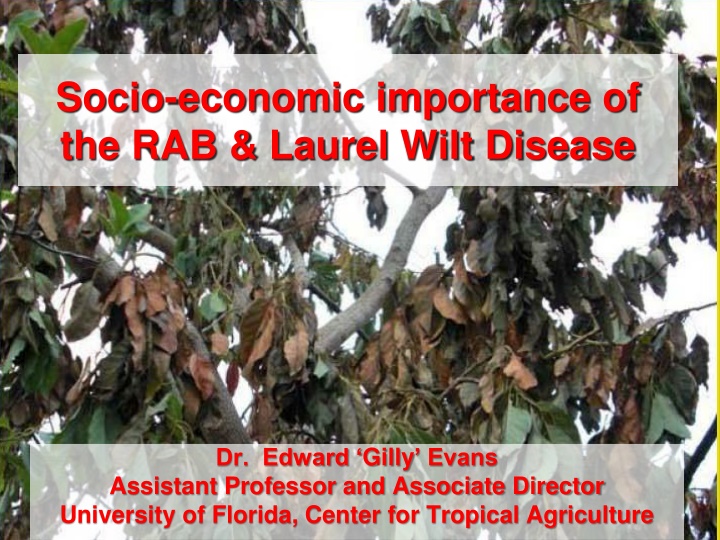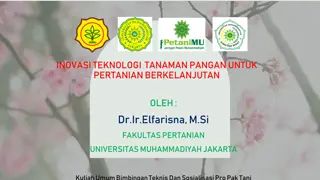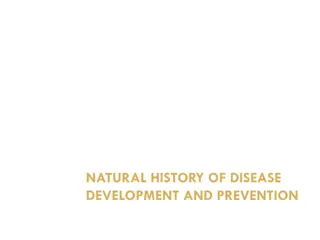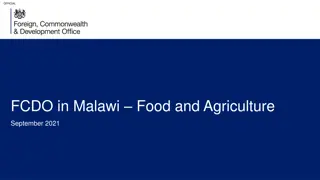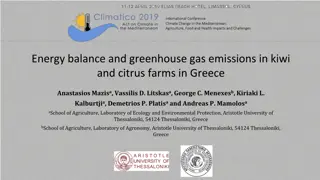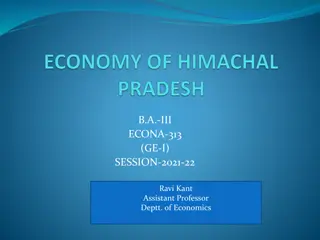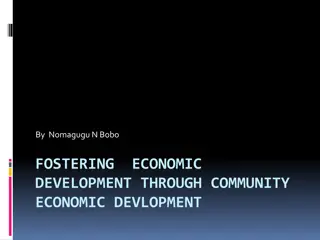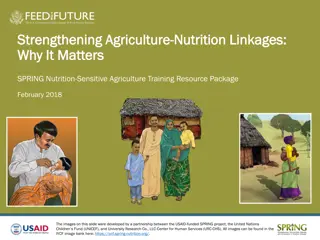Economic Impact of Laurel Wilt Disease on Local Agriculture
Dr. Edward Gilly Evans discusses the socio-economic importance of the RAB & Laurel Wilt Disease, estimating direct and indirect losses in the industry, and the economic impact on the local/regional economy. The potential financial implications, including reductions in production, industry sales, property values, and increased management costs, are outlined. Input-output models are used to analyze interdependencies among industries, employment impacts, labor income effects, and indirect business tax ramifications due to the disease.
Download Presentation

Please find below an Image/Link to download the presentation.
The content on the website is provided AS IS for your information and personal use only. It may not be sold, licensed, or shared on other websites without obtaining consent from the author.If you encounter any issues during the download, it is possible that the publisher has removed the file from their server.
You are allowed to download the files provided on this website for personal or commercial use, subject to the condition that they are used lawfully. All files are the property of their respective owners.
The content on the website is provided AS IS for your information and personal use only. It may not be sold, licensed, or shared on other websites without obtaining consent from the author.
E N D
Presentation Transcript
Socio-economic importance of the RAB & Laurel Wilt Disease Dr. Edward Gilly Evans Assistant Professor and Associate Director University of Florida, Center for Tropical Agriculture
Potential Economic Impact of the Laurel Wilt Disease on the Industry Estimate the direct losses: Discussions with industry experts, growers, extension agents Use internet tools such as tree value analysis tool available at http://agecon-trec.ifas.ufl.edu/TreeCostAvocado.htm Estimate the indirect or spillover losses (local impacts) Much more challenging; requires the use of an input-output model Use economic model known as IMPLAN input-output multipliers Focus on 3 scenarios:
Estimates of Direct Cost ($) Item Do Nothing 75% 50% Reduction in Production Reduction in Production Industry Sales Loss $30,000,000 $22,500,000 $15,000,000 Decline in Property Value $326,250,000 $244,688,000 $163,125,000 Increased Management Costs Total $3,510,000 $3,510,000 $356,250,000 $270,698,000 $181,650,000
Estimating the Economic Impact on Local/Regional Economy Input-Output model Interdependencies among industries and the associated primary factor of production Fertilizers Fertilizers $$$ labor income income $$$ labor Avocado Industry Packing materials materials Packing $$$ Gov. Tax $$$ Gov. Tax Output Output Chemicals Chemicals Inputs for other industries Inputs for other industries
Economic Impact of Laurel Wilt on the Local Economy Base Case 75% Reduction in Production 50% Reduction in Production Item Industry Sales $30,000,000 Total Economic Impact (output) Employment Impacts (FTE) Labor Income Impacts Indirect Business Tax
Economic Impact of Laurel Wilt on the Local Economy Base Case 75% Reduction in Production 50% Reduction in Production Item Industry Sales $30,000,000 Total Economic Impact (output) $54,266,259 Employment Impacts (FTE) 546 Labor Income Impacts $19,674,272 Indirect Business Tax $1,862,415
Economic Impact of Laurel Wilt on the Local Economy Base Case 75% Reduction in Production 50% Reduction in Production Item Industry Sales $30,000,000 $7,500,00 Total Economic Impact (output) $54,266,259 Employment Impacts (FTE) 546 Labor Income Impacts $19,674,272 Indirect Business Tax $1,862,415
Economic Impact of Laurel Wilt on the Local Economy Base Case 75% Reduction in Production 50% Reduction in Production Item Industry Sales $30,000,000 $7,500,00 Total Economic Impact (output) $54,266,259 $13,566,565 Employment Impacts (FTE) 546 136 Labor Income Impacts $19,674,272 $4,918,568 Indirect Business Tax $1,862,415 $465,605
Economic Impact of Laurel Wilt on the Local Economy Base Case 75% Reduction in Production 50% Reduction in Production Item Industry Sales $30,000,000 $7,500,00 $15,000,000 Total Economic Impact (output) $54,266,259 $13,566,565 $27,133,130 Employment Impacts (FTE) 546 136 273 Labor Income Impacts $19,674,272 $4,918,568 $9,837,136 Indirect Business Tax $1,862,415 $465,604 $931,208
Economic Impact of Laurel Wilt on the Local Economy Base Case 75% Reduction in Production 50% Reduction in Production Item Industry Sales $30,000,000 $7,500,00 $15,000,000 Total Economic Impact (output) $54,266,259 $13,566,565 $27,133,130 Employment Impacts (FTE) 546 136 273 Labor Income Impacts $19,674,272 $4,918,568 $9,837,136 Indirect Business Tax $1,862,415 $465,604 $931,208
Further Implications of Disease Complex
Table 1: Replacement cost based on value of avocado trees* Unit Miami-Dade Broward Palm Beach Lee TOTAL No. of commercial trees No. of backyard trees No. 643,800 870 2,610 7,830 655,110 No. 250,000 182,554 131,898 61,830 626,282 TOTAL TREES Replacement Cost (commercial) Replacement Cost (backyard) No. 893,800 183,424 134,508 69,660 1,281,392 $ 212,454,000 287,100 861,300 2,583,900 216,186,300 $ 82,500,000 60,242,721 43,526,275 20,403,970 206,672,967 TOTAL COST $ 294,954,000 60,529,821 44,387,575 22,987,870 422,859,267
Table 1: Replacement cost based on value of avocado trees* Unit Miami-Dade Broward Palm Beach Lee TOTAL No. of commercial trees No. of backyard trees No. 643,800 870 2,610 7,830 655,110 No. 250,000 182,554 131,898 61,830 626,282 TOTAL TREES Replacement Cost (commercial) Replacement Cost (backyard) No. 893,800 183,424 134,508 69,660 1,281,392 $ 212,454,000 287,100 861,300 2,583,900 216,186,300 $ 82,500,000 60,242,721 43,526,275 20,403,970 206,672,967 TOTAL COST $ 294,954,000 60,529,821 44,387,575 22,987,870 422,859,267
Wider Implications of Disease Complex
World Avocado Production Other countries 34% Latin America and Caribbean 66% 2008
Concluding Remarks Together, the ambrosia beetle and laurel wilt disease represent a serious threat to the Florida avocado industry. Currently, the industry generates an economic impact of over $54 million dollars, contributes to agricultural labor employment, and is a source of $1.9 million annually in government revenue. Longer term the disease complex represents a threat to California avocado industry as well as avocado production in Latin America and Caribbean countries.
